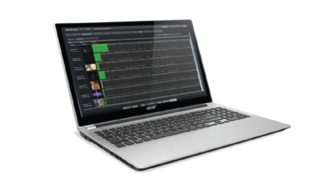Migrating broadcast operations to private cloud environments is increasingly popular, but for reasons of agility, efficiency and even creativity, but the future model may lie more in the direction of micro-services and the public cloud, according to the big broadcasting vendors
It is easy to imagine that the entire media industry has put up a sign saying ‘gone to the cloud’ with the same happy exuberance of a ‘gone to the pub’ notice posted on a friend’s front door.

It is also easy to imagine a time when private clouds run out of value and vanish, and the claim ‘born of the cloud’ is understood contextually. Micro services are a core part of this new software era.
Avid Technology VP of Platforms & Solutions Tim Claman, says: “Everyone has at least dipped their toe in the water, if they have not fully immersed themselves in the cloud. Users have some experience of it, whether they have done proof of concept, or because they have moved some aspects of their operation into the cloud. There is still a lot of exploration to be done.
“There is interest in private clouds, and the goal there is really technology convergence,” he adds.
This involves moving everything into IT data centres to drive greater utilisation and efficiency, and positioning for far greater levels of agility.
“Public cloud is seen more as an opportunity for increased elastic scalability, and a lot of users are thinking about private cloud for their fixed capacity needs. At this stage they use public clouds for their variable capacity,” says Claman.
Any additional capacity to that which people have built up on premises allows them to burst onto open cloud, and Claman observes a hybrid trend.
“A lot of exploration is still going on private cloud, mostly around IP conversion efficiency. It is all about agility and taking that variable capacity and moving it into a highly scalable environment, where they can spin resources up and down.”

Claman presented a paper on cloud potential at NAB, with a strong focus on content production.
“Content aggregators and distributors have been leveraging the cloud for several years, for everything from linear playout to transcoding and OTT distribution, and what I wanted to talk about was about the upstream content creation community and what they are doing with cloud. That doesn’t always get the same attention,” he says.
“The creative teams that craft the content have different motivations for cloud,” he continues. “The large media enterprises see cloud for the agility, efficiency, and integrating their content pipelines, but for individual artists and production companies it is really about collaboration and the elimination of friction in workflows.”
Claman’s theme here is ‘better creativity through connectivity’ and Avid is lucky because its customer base boasts thousands of creatives as well as huge companies in the owner/distributor sector.
Edit decisions
Avid offer three models for editing in the cloud – the first (MediaCentral | Cloud UX) comprises light editing tools in a browser, involving zero software install.

“In that scenario all the content is centralised, so it is not really edge processed in any way. You are making editing decisions in the thin client, and they are being applied to content centrally,” says Claman. “If you are a news journalist, all you need are basic editing tools, and it goes straight to air.”
A WAN connection is important to model one, and model two, Media Composer | Cloud VM, is similar but gives you full-featured nonlinear editing via Media Composer running in a virtual machine.
“At home or in the field and wanting to make edits to some content that is centrally stored, you can do it using Media Composer | Cloud VM (running on a machine in the data centre),” says Claman. “This is centralised heavy editing over a network connection.”
Option three is Media Composer | Cloud Remote. “With a copy of Media Composer on your laptop you are able to intermix high-res content locally with streamed content from the central facility,” says Claman. “You can work in the timeline interchangeably with local footage and the streamed proxies.”

You can avoid downloading the proxies, or maybe download them so that when you finish with a production or with editing your timeline you can publish the result back to base for playout. This is a hybrid concept Avid has developed over several years.
“We reinforced the portability of our MediaCentral platform, by adapting it to run in both private data centres and on the public cloud,” says Claman. “We offer detailed guidelines for configuring and deploying it on Azure.”
Of greater impact might be Avid’s On Demand solutions, which are planned for release at IBC.
“These are really SaaS offerings that you can access on demand; you could spin them up spin and down as you need them,” says Claman. “An appealing aspect of cloud is the elastic scalability in both directions, and not having to carry on with the capital burden indefinitely.”
Avid’s editorial on demand service couples video editing with cloud storage, workflow and asset management.
“So say I want five editors, 20Tb of storage, and a little bit of workflow on a per month basis,” Claman says. “This is one service we launched; we also launched shared library on demand and Avid Illuminate on Demand, which is a QC service. The first is a really compelling way to leverage the cloud to enable collaboration and content sharing.”
The on-demand services raise the joyous prospect of uploading a file and paying per program hour for the QC service, for example, when you are sending in a show to Netflix.
End of an era
This OPEX frontier suggests the end of CAPEX. “We still have both. Many companies still have a CAPEX orientation especially for their fixed capacity,” says Claman. “But increasingly we are seeing interest in OPEX models for variable capacity.
“There is so much disruption on the content distribution and consumption arena; that has driven upstream into the content creation world, where you can no longer have a factory or assembly line mentality for content creation. What we are seeing is a lot of interest in OPEX models for variable capacity,” he adds. “OPEX gives you that ability to say yes to business opportunities without a high financial cost outlay up front, and without a long-term commitment.”
Claman is also a fan of micro services: “They are compelling. When I think about them I see applications composed of loosely coupled services.
“That sounds very abstract, but it has a lot of practical benefits: you have the modularity to solve a variety of business problems, and you can use modularity to increase scalability without having to scale every component in the system,” he adds. “You can also use micro services for resiliency, so instead of having one service available for some mission critical task, you can also spin up three or four more for some period of time.”
‘There is tremendous competition between the public cloud providers. Over time private data centres will decrease – Tim Claman, Avid
Economics head in the right direction
Avid has built a micro services architecture into its MediaCentral platform, and it is fast refactoring monolithic legacy applications into micro services. So will private clouds eventually fade out due to the high cost of sustaining proprietary, strangled environments and the swell of OPEX options?
“Initially there was a lot of wariness of the public cloud – for economic, security and operational reasons, but people are learning that the public cloud is more resilient than any on premises infrastructure. There is no way they could build up the capacity to compete, and the same is true for data protection and security,” says Claman. “Microsoft has more security experts working on securing data on the public cloud than anyone will ever have in a private data centre.”
So public cloud beats private clouds at every level.
“The economics are going in the right direction because there is tremendous competition between the public cloud providers. Over time private data centres will decrease,” says Claman. “But right now we see a lot more investment in those and I see that as an intermediate step. People are migrating from a purpose-built specialised hardware in a machine room to a generic IP infrastructure, and that is a big step in itself. In the medium to long term the fundamentals will continue to improve for public cloud, and the comfort level people have will increase.”
In a different league
Chief Technology Officer for Grass Valley’s Media Business Unit Ian Fletcher is in accord with Claman on the confusion around ‘gone to the cloud’.
“In many cases people have done a lift-and-shift, taken traditional software and run it on virtual machines in a private or public data centre,” he says. “Effectively, this is out-sourcing your equipment room and just making the cable longer. You are not really leveraging the benefits of the true cloud architecture.
“From a playout perspective very few people have embraced cloud as it should be embraced,” he adds.

Fletcher is not ruling out the chance of private clouds slowly vanishing. “Public clouds are vastly in orders of magnitude more secure than a private data centre,” he says.
Pointing back at some of the disasters to hit private data centres (British Airways being one), he adds: “It would be hard to visualise that level of failure happening to a Google or Microsoft. They are designed to be in a different league.”
Like Avid, Grass Valley has invested a lot of R&D into being cloud credible through new technology; the iTX Flex is pretty clever.
“Technically it is follow-computing. Effectively it is blending the cloud with the ground and it has split the problem of playout into two pieces,” says Fletcher. “You can think of it as the control plane and the data plane. It puts all of the management software, all of the back-office stuff, and all of the user interface stuff into the true cloud, into Office 365 or Salesforce. It is a true multi-tenancy system that you just sign up for: you build playlists and monitor channels.”
iTX Flex does not impose any particular restriction on where you put the playout nodes that are to be attached to the cloud. If media is on premises, it makes no sense to put the playout nodes in the cloud for cost reasons.
“In that case we would say just leave the small commodity servers just running on premise: you only need a small number because all the back-office stuff is shifted out,” explains Fletcher.

“If you want to do the playout from the cloud, the same software modules can run either in a public or private data centre.
“It lets broadcasters mix and match,” he adds “You can think of iTX Flex as an edge technology approach because it is pure software for a start. This means we can leverage best in class codecs.”
Different software design
Under the bonnet is compressed and uncompressed support for SMPTE ST 2110.
“You can run that software on an edge that is maybe a small computer or small blade, and which is just running out at the point of use,” says Fletcher. “You are controlling and orchestrating it from your global public cloud, which is what we provide.”
He sees micro services as the distinction between a true cloud and lift-and-shift.
“Any micro services architecture is like a field of cows; you milk them, and it doesn’t mean anything to you,” said Fletcher. “Such an architecture consists of a cloud of small, individual and loosely-coupled elements, any one of which can die at any time and the system has to carry on functioning. That is a very different way of designing software.”
This is not something you can retrofit. All micro services have to be built from scratch, and Grass Valley did that with iTX Flex.
“Fundamentally, it is about doing more with less. Broadcasters have less to spend on playout because they now have to serve so many more platforms,” says Fletcher. “Playout used to be sacrosanct, but it is getting to be just one of the many things a broadcaster has to do. They want it to be simpler and don’t want the old complexity of month-long projects in order to spin up new channels.”
Service providers are increasingly becoming partners in the development of products like iTX Flex, because Grass Valley is not in the business of running or hosting TV channels.
“You still need service providers to offer those value-added services that they do,” says Fletcher.
‘From a playout perspective, very few people have embraced cloud as it should be embraced’ – Ian Fletcher, Grass Valley
ata management
The acquisition of SAM by Grass Valley owner Belden throws two streams of R&D nicely together – Grass Valley’s micro services, cloud and back-end orchestration, and SAM’s highly configurable and user-friendly HTML5 user interfaces. It also highlights the value of data analytics.
“The area where we are looking at using big data is around the management of the system – things like behaviour and technical errors. When all your software is running in the cloud and you cannot touch it or feel it, you need very good dashboards and analytics to tell you what the system is doing,” says Fletcher. “The software stack is becoming increasingly agnostic to the actual hardware it is running on.”
Fletcher does not recall a time when we were so technologically stretched out. “We are at a situation where companies at the sharp end are saying they do not want any facilities and that everything must be in the cloud,” he says. “And yet we still sell loads of SD equipment – master control systems with buttons, panels, and levers.
“You cannot ‘end of life’ those sort of products, because people still buy them. There is a huge technology inertia and what we might see is people jumping a generation,” he adds.
Fletcher has a warning for broadcasters to heed: “Now everybody is switching to software, the cost of how much compute it uses becomes a significant factor. It is important to understand the compute asks of different software solutions when looking at the whole ‘going to the cloud’ argument.”
Read more Transcoding in the cloud





















No comments yet